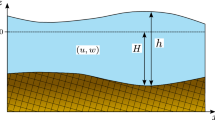Abstract
Absorbing/sponge layers used as boundary conditions for ocean/marine models are examined in the context of the shallow water equations with the aim to minimize the reflection of outgoing waves at the boundary of the computational domain. The optimization of the absorption coefficient is not an issue in continuous models, for the reflection coefficient of outgoing waves can then be made as small as we please by increasing the absorption coefficient. The optimization of the parameters of absorbing layers is therefore a purely discrete problem. A balance must be found between the efficient damping of outgoing waves and the limited spatial resolution with which the resulting spatial gradients must be described. Using a one-dimensional model as a test case, the performances of various spatial distributions of the absorption coefficient are compared. Two shifted hyperbolic distributions of the absorption coefficient are derived from theoretical considerations for a pure propagative and a pure advective problems. These distribution show good performances. Their free parameter has a well-defined interpretation and can therefore be determined on a physical basis. The properties of the two shifted hyperbolas are illustrated using the classical two-dimensional problems of the collapse of a Gaussian-shaped mound of water and of its advection by a mean current. The good behavior of the resulting boundary scheme remains when a full non-linear dynamics is taken into account.










Similar content being viewed by others
References
Beckers JM, Deleersnijder E (1993) Stability of a FBTCS scheme applied to the propagation of shallow-water inertia-gravity waves on various space grids. J Comput Phys 108:95–104
Berenger JP (1994) A perfectly matched layer for the absorption of electromagnetic waves. J Comput Phys 114:185–200
Berenger JP (2007) Perfectly matched layer (PML) for computational electromagnetics. Morgan and Claypool, San Rafael
Bermúdez A, Hervella-Nieto L, Prieto A, Rodrígez R (2007) An optimal perfectly matched layer with unbounded absorbing function for time-harmonic acoustic scattering problems. J Comput Phys 223:469–488
Blayo E, Debreu L (2005) Rebisiting open boundary conditions from the point of view of characteristic variables. Ocean Model 9:231–252
Cailleau S, Fedorenko V, Barnier B, Blayo E, Debreu L (2008) Comparison of different numerical methods used to handle the open boundary of a regional ocean circulation model of the bay of biscay. Ocean Model 25(1–2):1–16
Camerlengo AL, O’Brien JJ (1980) Open boundary conditions in rotating fluids. J Comput Phys 35:12–35
Chapman DC (1985) Numerical treatment of cross-shelf open boundaries in a barotropic coastal ocean model. J Phys Oceanogr 15:1060–1075
Collino F, Monk PB (1998) Optimizing the perfectly matched layer. Comput Methods Appl Mech Eng 164:157–171
Darblade G, Baraille R, Le Roux AY, Carton X, Pinchon D (1997) Conditions limites non réfléchissantes pour un modùle de Saint-Venant bidimensionnel barotrope linéarisé. Comptes Rendus de l’Académie des Sciences Paris 324:485–490
Davies HC (1976) A lateral boundary formulation for multi-level prediction models. Q J R Meteorol Soc 102:405–418
Engquist B, Majda A (1977) Absorbing boundary conditions for numerical simulation of waves. Math Comput 139:629–651
Flather R (1976) A tidal model of the north-west european continental shelf. Mémoires Société Royale des Sciences de Liège 10:141–164
Gan J, Allen JS (2005) On open boundary conditions for a limited-area coastal model off oregon. part 1: response to idealized wind forcing. Ocean Model 8(1–2):115–133
Hedström GW (1979) Non reflecting boundary conditions for non linear hyperbolic systems. J Comput Phys 30:222–237
Herzfeld M (2009) The role of numerical implementation on open boundary behaviour in limited area ocean models. Ocean Model 27:18–32
Holthuijsen LH (2007) Waves in oceanic and coastal waters. Cambridge University Press, Cambridge
Hu FQ (1996) On absorbing boundary conditions for linearized euler equations by a perfectly matched layer. J Comput Phys 129:201–219
Hu FQ (2001) A stable, perfectly matched layer for linearized euler equations in unsplit physical variables. J Comput Phys 173:455–480
Hu FQ (2008) Development of PML absorbing boundary conditions for computational aeroacoustics: a progress review. Comput Fluids 37:336–348
Israeli M, Orszag SA (1981) Approximation of radiation boundary conditions. J Comput Phys 41:115–135
Jensen TG (1998) Open boundary conditions in stratified ocean models. J Mar Syst 16(3–4):297–322
Lavelle JW, Thacker WC (2008) A pretty good sponge: dealing with open boundaries in limited-area ocean models. Ocean Model 20:270–292
LeBlond PH, Mysak LA (1978) Waves in the ocean. Elsevier oceanography series 20. Elsevier, Amsterdam
Marchesiello P, McWilliams JC, Shchepetkin A (2001) Open boundary conditions for long-term integration of regional oceanic models. Ocean Model 3:1–20
Martinsen EA, Engedahl H (1987) Implementation and testing of a lateral boundary scheme as an open boundary condition in a barotropic ocean model. Coast Eng 11:603–627
McDonald A (2002) A step toward transparent boundary conditions for meteorological models. Mon Weather Rev 130:140–151
Miller MJ, Thorpe AJ (1981) Radiation conditions for the lateral boundaries of limited-area numerical models. Q J R Meteorol Soc 107:615–628
Morse PM, Feshbach H (1999) Methods of theoretical physics. International series in pure and applied physics. McGraw-Hill, Boston
Navon IM, Neta B, Hussaini MY (2004) A perfectly matched layer approach to the linearized shallow water equations models. Mon Weather Rev 132:1369–1378
Nycander J, Döös K (2003) Open boundary conditions for barotropic waves. J Geophys Res-Oceans 108(C5):3168–3187
Nycander J, Hogg AM, Frankcombe LM (2008) Open boundary conditions for nonlinear channel flow. Ocean Model 24(3–4):108–121
Orlanski I (1976) A simple boundary condition for unbounded hyperbolic flows. J Comput Phys 21:251–269
Palma ED, Matano RP (1998) On the implementation of passive open boundary conditions for a general circulation model: the barotropic mode. J Geophys Res-Oceans 103(C1):1319–1341
Palma ED, Matano RP (2001) Dynamical impacts associated with radiation boundary conditions. J Sea Res 46(2):117–132
Pearson RA (1974) Consistent boundary conditions for numerical models of systems that admit dispersive waves. J Atmos Sci 31:1481–1489
Raymond WH, Kuo HL (1984) A radiation boundary condition for multi-dimensional flows. Q J R Meteorol Soc 110:535–551
Røed L, Cooper C (1986) Open boundary conditions in numerical ocean models. In: O’Brien JJ (ed) Advanced physical oceanography numerical modelling, vol 186. NATO ASI Series C, pp 411–436
Ruddick KG, Deleersnijder E, De Mulder T, Luyten PJ (1994) A model study of the rhine discharge front and downwelling circulation. Tellus 46A:149–159
Ruddick KG, Deleersnijder E, Luyten PJ, Ozer J (1995) Haline stratification in the rhine-meuse freshwater plume: a tree-dimensional model sensitivity analysis. Cont Shelf Res 15(13):1597–1630
Sommerfeld A (1949) Partial differential equations in physics. Academic Press
Treguier AM, Barnier B, de Miranda AP, Molines JM, Grima N, Imbard M, Madec G, Messager C, Reynaud T, Michel S (2001) An eddy-permitting model of the atlantic circulation: evaluating open boundary conditions. J Geophys Res-Oceans 106(C10):22115–22129
Acknowledgements
EJMD and ED are, respectively, Honorary Research Associate and Research Associate at the National Fund for Scientific Research (Belgium). This work was supported by the French Community of Belgium (RACE, ARC-05/10-333) and by the Interuniversity Attraction Poles Programme TIMOTHY-P6/13 (Belgian Science Policy). This paper is MARE publication n°181.
Author information
Authors and Affiliations
Corresponding author
Additional information
Responsible Editor: John Wilkin
Appendix: Semi-discrete model with linear decrease of linear waves
Appendix: Semi-discrete model with linear decrease of linear waves
Consider the semi-discrete linear wave equations on a staggered grid
where Δx is the grid size and σ j − 1/2 and σ j are so far undetermined absorption coefficients.
We request that the semi-discrete solution decreases linearly on a distance δ = NΔx, i.e.,
where x j − 1/2 = (j − 1/2)Δx and x j = jΔx.
Substituting Eq. 46 into Eq. 44 leads to the dispersion relation
and the value of the absorption coefficient needed to have a solution with a linear decrease
Rights and permissions
About this article
Cite this article
Modave, A., Deleersnijder, É. & Delhez, É.J.M. On the parameters of absorbing layers for shallow water models. Ocean Dynamics 60, 65–79 (2010). https://doi.org/10.1007/s10236-009-0243-0
Received:
Accepted:
Published:
Issue Date:
DOI: https://doi.org/10.1007/s10236-009-0243-0




